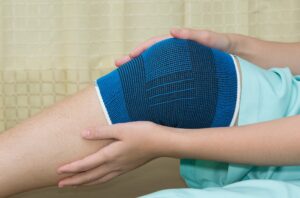 Compression wear for wound care is a type of fabric that helps to reduce the amount of blood flowing to an area of the body. Compression wear works with other types of wound care, such as pressure garments and dressings.
Compression wear for wound care is a type of fabric that helps to reduce the amount of blood flowing to an area of the body. Compression wear works with other types of wound care, such as pressure garments and dressings.
How Does Compression Wear Work?
When you put on a compression garment, it applies pressure to the skin by compressing the area around it. The more tightly you wrap a limb or an area of your body, the more pressure you will apply. This can help reduce swelling and pain associated with wounds or injuries.
How Are Compression Garments Used?
Compression garments are worn over the body to help reduce edema and help keep blood cells flowing. You can also wear them to improve circulation, which can help prevent clotting problems in patients with heart or peripheral vascular disease.
You can use compression garments for exercises, such as running or cycling, to increase muscle oxygenation and blood flow. You can also use compression after surgery to reduce swelling and encourage healing.
Compression is most commonly used following surgery or illness when swelling occurs. Compression can be used as a treatment for many types of swelling and edema, including:
- Postoperative edema (swelling)
- Cardiac-related edema (fluid buildup in the lungs)
- Pulmonary edema (fluid buildup in the lungs)
- Peripheral vascular disease (injury to arteries that supply blood to legs or arms)
Types of Compression Wear for Wound Care
Here are the types of compression wear:
Elastic Compression
Elastic compression bandages are the most commonly used elastic bandages for wound care. They are available in different sizes and thicknesses, which can be adjusted to fit the patient’s wound. The primary function of elastic compression bandages is to provide a tight but comfortable stretch around the affected area. The bandage is applied by wrapping it around the injured area and tying it using a knot or string.
Although elastic compression bandages are more commonly used for wounds on the lower leg, you can also use them for other types of injuries such as splints, burns, and cuts. Elastic compression bandages are generally worn overnight or for up to 4-6 hours. You must remove the bandage before showering or swimming because it can irritate sensitive skin.
Compression Socks
Compression socks are thin nylon socks that fit under your everyday shoe. They are worn on top of your regular socks or shoes and support weak bones or muscles in your legs by compressing them against the skin surface underneath them. They work best for people with shortness of breath caused by poor circulation in their legs, such as those with peripheral arterial disease or chronic venous insufficiency (CVI).
Elastic Adhesive Bandage
Elastic adhesive bandage. An elastic or stretchy bandage is a soft material that you can wrap around the body to cover wounds. Elastic bandages are available in different sizes, including large and small. Some are designed to fit up to a size 18 wrist, and others will wrap around more giant legs or arms.
The elastic bandage is applied by wrapping it around the wrist or ankle, then securing it with a strap with Velcro or another type of fastener. The two ends are then folded together to create a secure seal around the wound. The elastic bandage uses pressure from its fabric to keep its shape as it stretches over an inflamed wound, providing compression and support for healing.
Compression Bandages
Compression bandages are a type of bandage used to control bleeding by applying pressure to the wound. They are made from elastic material and are available in various sizes, shapes, and fabrics. The bandage is usually wrapped around the limb/area where you must apply pressure. You may use them when there is an injury or ulcer on your skin or when you have an open wound.
Compression Stocking
A compression stocking is another type of compression garment that provides additional support and healing benefits. You can wear it under regular clothing, pants, and shoes, or in the shower or bathtub. The stocking has a layer of absorbent material between two layers of fabric that helps draw moisture away from the skin and promote healing. Compression stockings are available in different levels of compression strength depending on your needs; choose one that’s appropriate for your injury or condition.”
Velcro Compression
Velcro compression is an easy way to apply pressure on wounds. Velcro is sewn into the bandage to help hold it in place while still allowing it to move with your body. This helps reduce swelling and pain, as well as speed healing time. Velcro compression wear helps reduce inflammation by keeping the blood flow going through your body at a higher rate than normal blood flow allowing for normal healing processes.
Padded Compression
Padded compression is another type of compression wear that supports the leg but does not wrap around it as elastic does. The padding helps keep skin from rubbing against itself or other surfaces, which could cause discomfort or irritation. Healthcare workers can use padded compression in combination with other types of compression wear or alone as needed by patients who have ongoing issues with their skin.
Prefabricated Wraps
Prefabricated wraps are a type of compression wear made from pre-cut and pre-punched material to fit the patient. They can be used as a compression wrap or support stocking, depending on how they are worn. They are typically wrapped around the lower leg and thigh area and then secured with elastic ties or Velcro closures to provide support and stability.
V-Shirts and Knee-Highs
V-Shirts and Knee-Highs are other types of compression wear worn by patients with wounds or ulcers on their legs or feet. These compression garments provide extra support and stability when walking or standing. You can use the garments to help prevent blood clots in patients with clotting disorders.
Zinc Oxide Tape
Zinc oxide tape is available in rolls or strips so you can cut it to size for your wound. The tape has an adhesive backing that will stick to the wound area but not your skin. There are no harmful chemicals used in its manufacture.
The primary benefit of using zinc oxide tape for wound care is its antimicrobial properties. It helps prevent bacterial growth by killing off microbes that cause infections. It also acts as an antiseptic on wounds by helping them heal faster without any risk of infection.
Lymphedema Compression Wear
A unique type of compression wear made from polyester and spandex. Lymphedema compression clothing helps to manage swelling in the legs and feet. Lymphedema is the abnormal fluid accumulation in the body, which may cause swelling around the arms, legs, and feet. It’s a common condition that can affect people with lymphedema and those who have recently undergone surgery or other medical treatments.
Lymphedema compression wear comes in many different styles and sizes, including:
- Tights – These are ideal for people with moderate to severe lymphedema who need extra support during their rehabilitation or after surgery. They’re available in various sizes that cover the whole leg area.
- Pants – Pantyhose-style pants allow you to wear regular pants underneath them without any visible panty lines or bulges on top of your shoes. These are also great for people who want something more comfortable than tight tights or might have trouble wearing tight tights due to skin irritation or rash due to prolonged exposure to moisture.
Benefits of Compression Wear for Wound Care
Compression wear for wound care is an excellent alternative to surgical drainage, which can be very expensive. In addition, compression garments also allow for debriding of the wound, which can make your stitches less noticeable.
The benefits of using compression wear for wound care include:
- Help control inflammation by reducing edema fluid buildup and decreasing blood flow to the area.
- Provide support to the wound, which can improve healing time.
- Have antibacterial properties that keep bacteria from spreading through wounds.
- Another benefit of wearing compression garments after surgery is that they can help protect against infection by reducing friction between different layers of tissue within the wound site.
- It helps prevent blood loss.
- It promotes wound healing.
- It reduces pain and swelling.
- It improves circulation, oxygenation, and nutrition at the wound site.
Compression is vital for the management of wounds. More patients should adopt compression because it reduces the amount of blood flow to the wound, which reduces the risk of infection. It also prevents the wound from becoming anaerobic, aiding healing.
For inquiries, please email our office at [email protected], and we will send a quick reply will be sent about your condition. If you require a personal consultation that requires an appointment, please call the office today at 416-782-5353.


